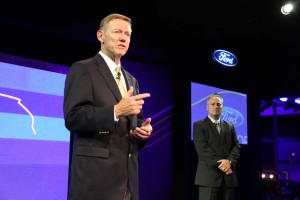This is an update of an earlier report on TheDetroitBureau.com.
Ford Motor Co. has confirmed it expects to boost global sales by 50% by mid-decade, the lion’s share of that increase coming from emerging markets like China.
That would boost the maker’s worldwide sales from 5.3 million last year to around 8 million, putting it on a par with industry giants like General Motors, Volkswagen and the 800-pound gorilla of the auto world, Toyota, which sold 8.42 million vehicles in 2010.
Notably, Ford is expecting to put an increasing emphasis on small cars, rather than the trucks that long dominated its product line-up. It is projecting that small vehicles will account for 55% of its worldwide volume by 2020.
- Though Ford is looking at growth in all its key markets, including North and South America, as well as Europe, Mulally is expected to put an emphasis on its Asia-Pacific-Africa division. Currently, those regions account for 15% of total Ford volumes worldwide, but the maker expects to bump that to a full third by 2020.
Industry analysts expect Ford to take advantage of the growth in emerging markets, notably India and China, the latter now the world’s largest national automotive market. But they also caution that Ford was a relative late-comer in China and is paying a significant price for its initial hesitation. It currently holds a modest 4% share of that market compared to 15% for GM, now the industry leader.
Ford officials downplay their late start, however. In a conversation with TheDetroitBureau.com, earlier this year, Mulally said that Ford hopes to tap into the second wave of growth in China. While demand is leveling out in already traffic-choked cities like Beijing and Shanghai, demand is just beginning to take off in second and third-tier cities further away from China’s Pacific coast. Indeed, GM has a similar strategy, which is why it recently launched an all-new brand dubbed Baojun.
Mulally has radically transformed Ford since joining the company more than four years ago. His over-arching corporate strategy has been dubbed One Ford, and the foundation is merging the maker’s various global product development operations so it can roll out an array of products suitable for markets worldwide.
The new 2012 Ford Focus is a good example, with the versions sold in the U.S. and Europe, for example, sharing about 80% of their parts and components. Meanwhile, the underlying product platform is flexible enough to permit Ford to come up with at least 10 “top hats,” or different bodies, including the C-Max microvan, which recently launched in Europe. It will come to the U.S. next year.
Though Ford is not giving up on big trucks like the F-150, long the best-selling vehicle in the U.S., it is putting more of an emphasis on high-mileage passenger cars and crossovers, Derrick Kuzak, the global product development chief, promising that “We intend to be the fuel economy leader or at least one of the top brands when it comes to fuel economy in every segment where we compete.”
To focus on the global ambitions of the familiar Ford “Blue Oval” brand, Mulally ordered the sale of the suburban Detroit maker’s global brands, Volvo, Jaguar, Land Rover and Aston Martin. That was a significant shift from his predecessors, former CEO Jacque Nasser once promising those luxury marques would ultimately account for a third of Ford’s total profits.
In the end, they never delivered and Mulally was convinced the company’s resources had to be more sharply focused. He even ordered the closure of the long anemic Mercury division.
Without so many mouths to feed, Ford says it is rapidly expanding the pace of its product development efforts, and it expects that be 2014 it will have refreshed 140% of its models compared to 2014 — meaning many lines will go through two updates in a relatively short 5-year window.
The one big uncertainty, when it comes to brands, is the Lincoln luxury line, which is but a shadow of its once-grand past, when it went head to toe with GM’s Lincoln for dominance in the American market.
Earlier this week, GM CEO Dan Akerson took a pot shot at Lincoln, insisting the brand is “over,” and that it is time to “sprinkle holy water over it.”
Ford officials clearly don’t see things the same way, though in a conversation last week, Kuzak acknowledged it will take some years of rebuilding for Lincoln. He also cautioned that Ford will only try to market its luxury marque overseas after it proves its viability in the U.S. – which remains the world’s largest luxury market.
Ford has other challenges ahead of it. The maker is still burdened with more debt than its cross-town rivals, in large part due to its decision to mortgage its assets for $26 billion prior to the recent economic meltdown.
But there are signs the decision is paying off, Ford not only boosting market share in 2010 but reporting $6.6 billion in profits. It added another $2.6 billion in earnings for the first quarter of 2011, well above industry expectations.
Nonetheless, Mulally appears to buy into the contention of industry analysts that Ford must continue to shift its focus beyond U.S. shores if its recent successes are to be repeated into the future.

